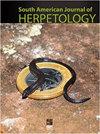开放塞拉多地区较高的多样性支持了区域过程在巴西东南部形成Anuran组合中的作用
IF 0.7
4区 生物学
Q4 ZOOLOGY
引用次数: 5
摘要
摘要在这项研究中,我们通过对巴西东南部不同塞拉多植被类型多样性模式的了解,评估了当地和区域因素在塞拉多生物群落中无核群落形成中的作用。我们使用带漂移围栏的陷阱和标准化的努力,在植被结构复杂性的梯度中测量了地面蛙的丰富度和丰度,从草原(campo sujo)到森林(cerradão)各不相同。我们还通过直接计算野外植被的组成部分来测量植被结构。我们发现植被类型之间的丰富度和丰度存在差异,在更开阔的植被类型中,丰富度更高,而森林中的丰度更高,这是因为大西洋森林生物群落中的一种Rhinella ornata的捕获数量极高。无核生物多样性和植被结构的一致模式表明,栖息地在该群体的多样性结构中发挥着重要作用,开放植被类型共享更相似的无核生物组合和植被。在巴西东南部的开放植被类型中观察到的无尾蛇的更高多样性与整个生物群落中其他爬行动物的多样性是一致的,这支持了区域过程相对于局部决定论的普遍性,这一假设应该通过大规模标准化采样对两栖动物进行正式测试。本文章由计算机程序翻译,如有差异,请以英文原文为准。
Higher Diversity in Open Cerrado Supports the Role of Regional Processes in Shaping an Anuran Assemblage in Southeastern Brazil
Abstract. In this study, we evaluate the role of local and regional factors in shaping the anuran assemblages in the Cerrado biome by contributing to the knowledge on the diversity patterns of different Cerrado vegetation types in southeastern Brazil. We measured richness and abundance of ground dwelling frogs in a gradient of vegetation structural complexity, varying from grassland (campo sujo) to forest (cerradão), using pitfall traps with drift fences and standardized efforts. We also measured vegetation structure by directly counting its components in the field. We found differences in richness and abundance among vegetation types, with richness being higher at more open vegetation types, and abundance being higher at the forest due to the extremely high number of captures of Rhinella ornata, a species from the Atlantic Forest biome. A concordant pattern in anuran diversity and vegetation structure suggests an important role of the habitat in structuring diversity in this group, with open vegetation types sharing both more similar anuran assemblages and vegetation. The higher diversity of Cerrado anurans observed in the open vegetation types in southeastern Brazil is in phase with diversity accounts for other groups of the herpetofauna throughout the biome, and it supports a prevalence of the regional processes over local determinism, a hypothesis that should be formally tested for amphibians with large-scale standardized sampling.
求助全文
通过发布文献求助,成功后即可免费获取论文全文。
去求助
来源期刊
CiteScore
1.50
自引率
0.00%
发文量
10
期刊介绍:
The South American Journal of Herpetology (SAJH) is an international journal published by the Brazilian Society of Herpetology that aims to provide an effective medium of communication for the international herpetological community. SAJH publishes peer-reviewed original contributions on all subjects related to the biology of amphibians and reptiles, including descriptive, comparative, inferential, and experimental studies and taxa from anywhere in the world, as well as theoretical studies that explore principles and methods.

 求助内容:
求助内容: 应助结果提醒方式:
应助结果提醒方式:


